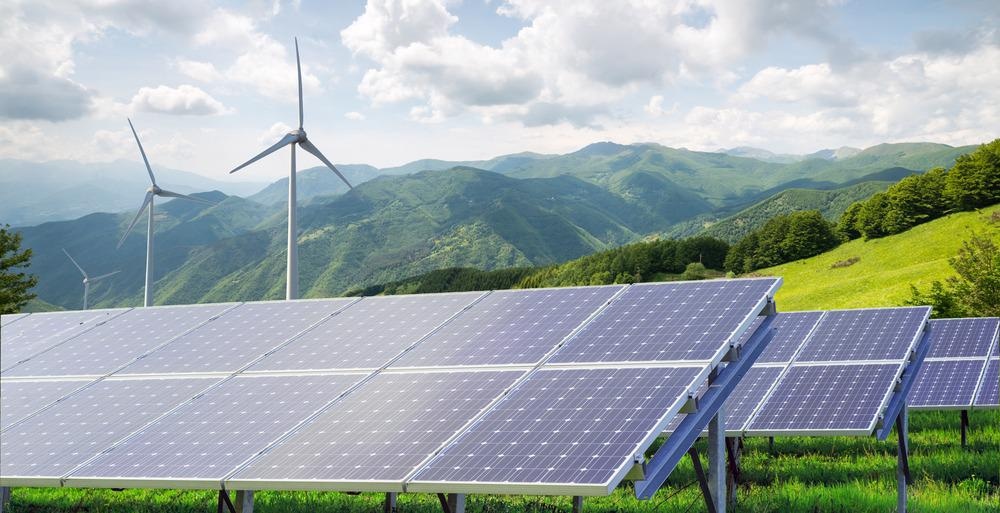The problem with many sources of renewable energy - such as the sun, wind and waves - is that their intensity fluctuates. Solar power is unproductive at night or on especially cloudy days, while wind power depends on the speed of the wind, the forecasting of which is difficult.

Image Credit: geniusksy/Shutterstock.com
For all their faults, coal and gas (as well as some renewable sources, such as hydropower) provide constant and ‘dispatchable’ on-demand energy for the electricity grids they feed. The electricity grids are responsible for balancing energy generation and consumption; if one end of this equation is relatively reliable, predictable and flexible, it makes this challenging task easier.
If we want our power grids to be powered by renewable energy sources instead of fossil fuels while keeping them reliable and flexible, we will need effective forms of grid-scale energy storage. Energy storage systems will hoard excess energy when conditions are optimal, such as when the sun is bright, skies are clear and wind is blowing, and draw on it when conditions are not. They will turn renewable energy sources into reliable and dispatchable energy generation systems.
Compressed Air Energy Storage
One way to store energy is using the elastic potential of compressed air in a system called Compressed Air Energy Storage (CAES). During off-peak periods, low-cost power is used to power motors that compress air and store it in underground caverns, usually disused salt mines, under very high pressures. In peak-load periods, this compressed air is then released and combusted with fuel to force it to expand. This drives a gas turbine to produce electricity.
An estimated 100 million barrels of oil could be saved if current gas turbines in the United States were replaced by CAES plants. Compared with other grid-scale energy storage methods, such as lithium batteries, CAES systems have high power ratings and storage capacity, and long lifetimes.
A History of Compressed Air Energy Storage
CAES is not a new technology. The first CAES plant was built in Huntorf, in the north of Germany, in 1978 to baseload the power of the nearby nuclear station in Unterweser.
The Huntorf plant has two 650-800-meter-deep underground salt caverns with a combined volume of 310,000 m3, which take eight hours to fill to volume with compressed air stored at 46-72 bar. When this air is released and combusted using natural gas, it drives a turbine which produces 290 MW of electricity for two hours. Overall, the Huntorf plant uses 0.8 kWh of electricity and 1.6 kWh of gas to produce 1 kWh of electricity, making it approximately 40% efficient.
To date, the only other comparable CAES plant is the McIntosh power plant in Alabama, USA, built in 1991, which is in many ways superior to the Huntorf plant. The McIntosh plant’s underground storage cavern is 538,000 m3 and takes approximately 45 hours to charge. It can produce 110 MW of electricity for 26 hours: approximately 2860 MWh – five times as much as in Huntorf. The McIntosh plant can also recycle some of the waste heat from the gas turbine’s exhaust, which increases the efficiency of the system to 54%.
CAES plants face two major challenges which have prevented them from being more widely adopted. Firstly, they are typically less efficient than other grid-scale energy storage technologies. The initial compression of the air produces an enormous amount of heat energy which, unless reversed, becomes wasted. For even moderate pressures, extreme temperatures of 1000 °C can be reached. Secondly, the requirement for large underground caverns with specific geological requirements introduces site constraints. However, it should be noted that these siting constraints are not as severe as those faced by pumped hydro plants, which are currently by far the largest-capacity form of grid-scale energy storage available, accounting for more than 95% of all storage installations worldwide.
Hydrostor’s Advanced Compressed Air Energy Storage
Advanced Compressed Air Energy Systems (A-CAES) systems make significant improvements to CAES plants to overcome these limitations. Hydrostor, founded in 2010 and based in Toronto, Canada, is building a series of large-scale A-CAES plants across the USA, Canada, Chile, and Australia.
With Hydrostor’s design, heat is extracted from compressed air and stored inside a proprietary thermal storage system for use later in the cycle. The compressed air itself is stored in unique caverns where hydrostatic compensation is leveraged to maintain the system at a constant pressure. This hydrostatic pressure is used to release the air again, where it is then combined with the heat stored earlier in the cycle, expanding it and generating power through a turbine.
The Hydrostor plant upgrades the original CAES plant by increasing its efficiency and site flexibility and eliminating all dependence on fossil fuels. Hydrostor sites have a significantly less environmental impact during their construction. Plants typically produce between 200 to 500 MW of power.
How Hydrostor Is Enabling The Energy Transition
Video Credit: Hydrostor/Youtube.com
The Future of Hydrostor and A-CAES
With the future of renewable energy development highly dependent on smart grid-scale energy storage solutions such as A-CAES, the company predicts significant growth in the near future, including entry into new markets.
References and Further Reading
Hydrostor [Online]. Available at: https://www.hydrostor.ca/ (Accessed on 8th July 2021).
Compressed Air Energy Storage [Online]. ScienceDirect. Available at: https://www.sciencedirect.com/topics/engineering/compressed-air-energy-storage (Accessed on 8th July 2021).
Compressed Air Energy Storage [Online]. Energy Systems and Energy Storage Lab. Available at: http://www.eseslab.com/ESsensePages/CAES-page (Accessed on 8th July 2021).
Huntorf power plant – Kraftwerk Huntorf [Online]. SecondWiki. Available at: https://second.wiki/wiki/kraftwerk_huntorf (Accessed on 8th July 2021).
Energy Storage Projects [Online]. U.S. Department of Energy, Energy Storage Systems Program. Available at: https://www.sandia.gov/ess-ssl/global-energy-storage-database-home/ (Accessed on 8th July 2021).
Disclaimer: The views expressed here are those of the author expressed in their private capacity and do not necessarily represent the views of AZoM.com Limited T/A AZoNetwork the owner and operator of this website. This disclaimer forms part of the Terms and conditions of use of this website.